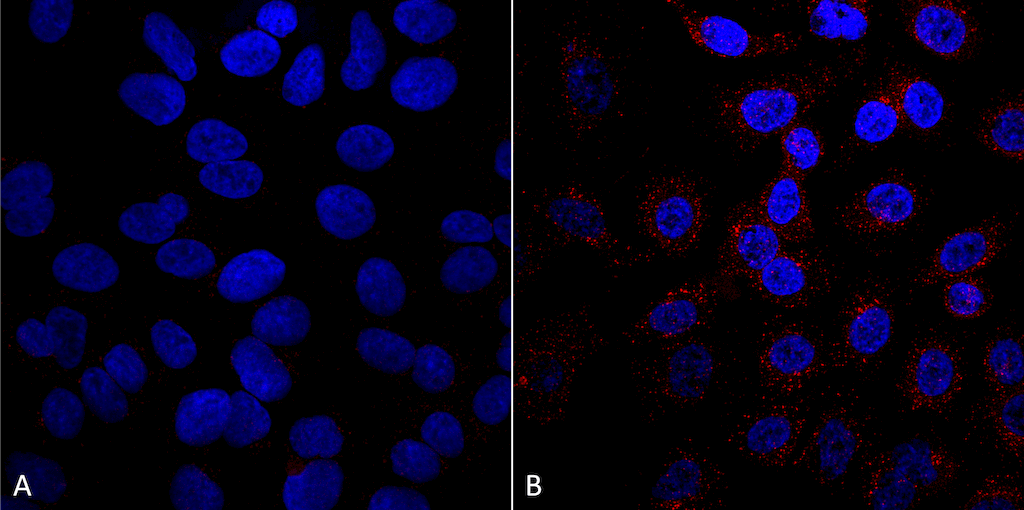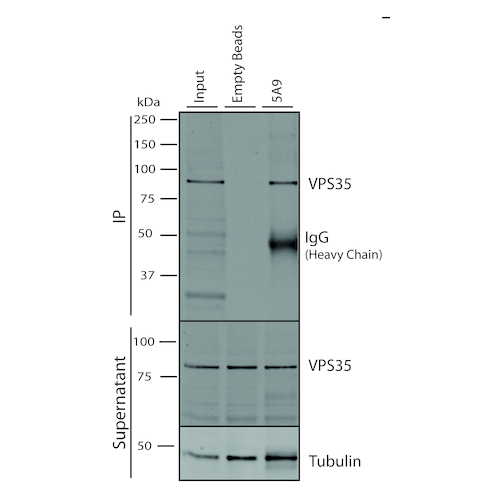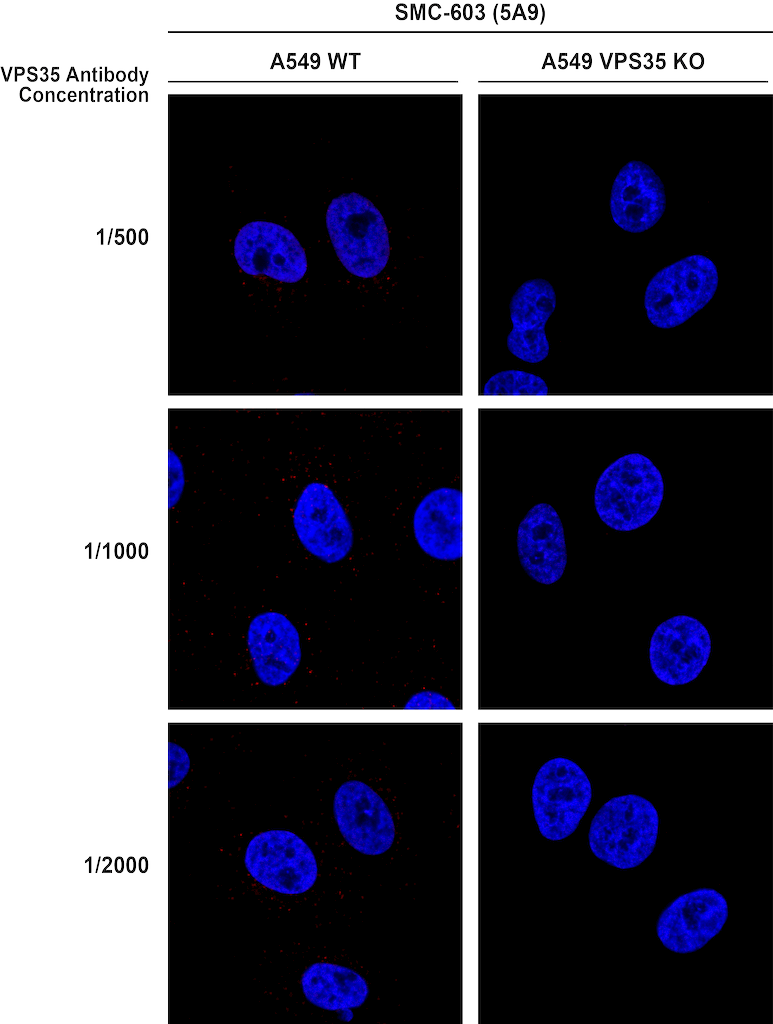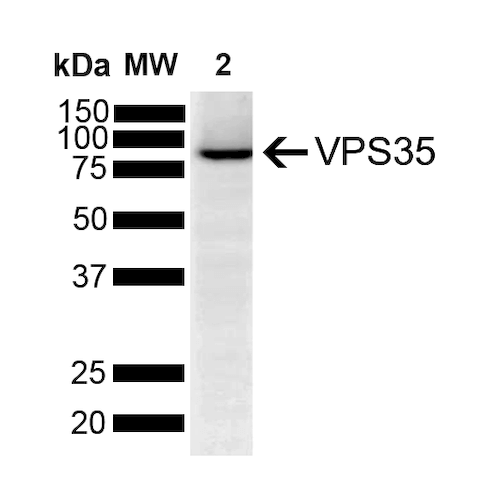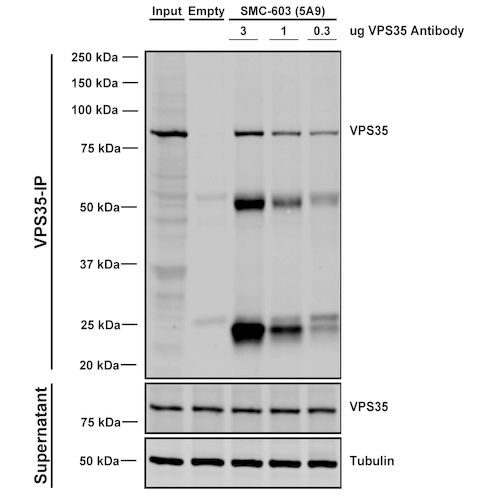VPS35 Antibody
VPS35 Antibody, Clone 5A9
- SPECIFICATION
- CITATIONS
- PROTOCOLS
- BACKGROUND

| Primary Accession | Q96QK1 |
|---|---|
| Other Accession | NP_060676.2 |
| Host | Mouse |
| Clonality | Monoclonal |
| Target/Specificity | VPS35 |
| Other Names | Vacuolar protein sorting-associated protein 35, MEM3, PARK17, VPS35 retromer complex component, maternal-embryonic 3, vesicle protein sortin 35, TCCCTA00141, FLJ10752 |
| Clone Names | VPS35 |
| Immunogen | Full length recombinant human VSP35 |
| Purification | Protein G Purified |
| Storage | -20ºC |
| Storage Buffer | PBS pH 7.4, 50% glycerol, 0.09% Sodium azide *Storage buffer may change when conjugated |
| Shipping Temperature | Blue Ice or 4ºC |
| Certificate of Analysis | A 1:1000 dilution of SMC-603 was sufficient for detection of VPS35 in 10 µg of SH-SY5Y by ECL immunoblot analysis using Goat Anti-Mouse IgG:HRP as the secondary antibody. |
| Cellular Localization | Endosome | Lysosome | Vesicles | Cytoplasm | Membrane |

Thousands of laboratories across the world have published research that depended on the performance of antibodies from Abcepta to advance their research. Check out links to articles that cite our products in major peer-reviewed journals, organized by research category.
info@abcepta.com, and receive a free "I Love Antibodies" mug.
Provided below are standard protocols that you may find useful for product applications.
Background
Vacuolar Protein Sorter-35 (VPS35) is a component of the retromer complex, which is essential for endosome-to-Golgi retrieval of membrane proteins. VPS35 mutations such as D620N have been linked to Parkinson’s Disease (PD) (1,2) and affect retromer function, protein homeostasis, and mitochondria (3).
References
1. Vilarino-Guell, C. et al. (2011) Am J Hum Genet 89:162–167
2. Zimprich, A. et al. (2011) Am J Hum Genet 89:168–175
3. Rahman, A.A., Morrison, B.E. (2019) Neurosci 401:1-10.
If you have used an Abcepta product and would like to share how it has performed, please click on the "Submit Review" button and provide the requested information. Our staff will examine and post your review and contact you if needed.
If you have any additional inquiries please email technical services at tech@abcepta.com.













 Foundational characteristics of cancer include proliferation, angiogenesis, migration, evasion of apoptosis, and cellular immortality. Find key markers for these cellular processes and antibodies to detect them.
Foundational characteristics of cancer include proliferation, angiogenesis, migration, evasion of apoptosis, and cellular immortality. Find key markers for these cellular processes and antibodies to detect them. The SUMOplot™ Analysis Program predicts and scores sumoylation sites in your protein. SUMOylation is a post-translational modification involved in various cellular processes, such as nuclear-cytosolic transport, transcriptional regulation, apoptosis, protein stability, response to stress, and progression through the cell cycle.
The SUMOplot™ Analysis Program predicts and scores sumoylation sites in your protein. SUMOylation is a post-translational modification involved in various cellular processes, such as nuclear-cytosolic transport, transcriptional regulation, apoptosis, protein stability, response to stress, and progression through the cell cycle. The Autophagy Receptor Motif Plotter predicts and scores autophagy receptor binding sites in your protein. Identifying proteins connected to this pathway is critical to understanding the role of autophagy in physiological as well as pathological processes such as development, differentiation, neurodegenerative diseases, stress, infection, and cancer.
The Autophagy Receptor Motif Plotter predicts and scores autophagy receptor binding sites in your protein. Identifying proteins connected to this pathway is critical to understanding the role of autophagy in physiological as well as pathological processes such as development, differentiation, neurodegenerative diseases, stress, infection, and cancer.
